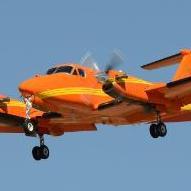Leaderboard
Popular Content
Showing content with the highest reputation on 05/12/2022 in all areas
-
Hi Coop... So I unplugged the monitor, and then ran it from the laptop monitor and yes, the Gizmo login screen was visible! I logged in and now the G5 works. So the key point I learned is to open xPlane11 with just the one screen and the login is visible. thanks for your help. Paul2 points
-
1 point
-
I don't know if this has been reported as a "wishlist" item. When the FO states Flaps.... (brief pause) 20... but the flaps are still coming down. Ideally, in the real world, it's a 2 pilot verification procedure-, FO calls flaps XX (selected)..... when it indicates 20, the CA states: "20 set/checked" Can we have our Hot Start automated FO wait for the flaps to reach 20 before stating 20? And/or add the ability to manually "check" the item like other checklist items?1 point
-
The levers on our 650 are definitely metal. If they appear black in X-Plane, it is indeed a lighting quirk within the sim at certain angles of the sun and certain times of day1 point
-
Hi guys, had our pilots take this little video on the aircraft VID-20220510-WA0004.mp41 point
-
View File F-HTTL Challenger 650 French registered Challenger 650 Submitter reversethrust Submitted 05/10/2022 Category Hot Start Challenger 650 Livery For https://www.x-aviation.com/catalog/product_info.php/take-command-hot-start-challenger-650-p-2121 point
-
Version 1.1.0
511 downloads
Jet Edge now operates Challenger 605s as part of their branded fleet. Jet Edge is based in Southern California and was bought in 2022 by Vista. This is in no way affiliated with Jet Edge and is offered for free for community enjoyment only. Please do not modify and redistribute without permission.1 point -
This isn't just about online ATC programs--the nonstandard altimetry breaks compatibility with other utilities that determine altitude using the provided X-Plane dataref. Why can't Hot Start just provide a user switch to turn the "realistic" altimetry off? It's got to be a whole lot simpler than auto-detecting online communications from specific ATC programs, and it would preserve the option to employ the standard interface to X-Plane. This *is* a Hot Start issue--this is the *only* add-on I am aware of that chooses to do its altimetry independently of the X-Plane platform dataref, which breaks compatibility with anything not specifically coded for that...in other words, lots of stuff. In my case it's Radar Contact v4, which is not being developed any longer but which works flawlessly with any aircraft that adheres to use of the standard platform dataref. It's also an issue with the Pilot2ATC and PF3 offline ATC add-ons as well. Why is it considered preferable to build complex auto-detection routines in for a select group of ATC clients, rather than just allowing the user to de-select the nonstandard HotStart altimetry with a tickbox?1 point
-
I'm going to put in my two cents worth, and my procedure will differ somewhat from what the "schoolhouse" teaches. Let's talk about the easiest scenario, which is an RNAV (GPS) or RNP approach to LPV or LNAV/VNAV line of minima. The minima for these approaches are specified as a decision altitude or DA. They provide the same TERPS or PANS-OPS protection for a momentary descent below the DA as does an ILS approach. From the initial approach fix (IAF) inbound, you should have VNAV selected. You may use VVS, VFLC, or VPTH to descend the aircraft through the initial and intermediate segment step down fix altitudes, and VNAV will honor all of them. However, the easiest is to fly VPTH and let the VNAV track the vertical path through each of the stepdown fix altitudes to the final approach fix crossing altitude. You may select the APP button at any time after the final approach fix. Once selected, the Vertical Glidepath (VGP) mode will be armed (shown as a white VGP in the FMA) and will become the active mode during the in the intermediate segment sometime past the (IF) fix. There are two important things about the VGP mode: 1. It will not honor the altitude preselector set altitude. If you're not cleared for the approach, if VGP has captured, it will descend on the final past the FAF. Once VGP is annunciated in Green, you can set the missed approach altitude just like on an ILS 2. On very hot days, e.g., 40C plus, VGP may not honor intermediate segment stepdown altitudes. The reason for this is that VGP mode from the IF fix inbound uses SBAS to compute the vertical path, which is not affected by non-standard temperatures, and like an ILS glideslope will take you below the intermediate segment stepdown altitudes on a very hot day. So, on a very hot day, you might want to stay in VPTH mode until passing the last stepdown fix in the intermediate segment, then press the APP mode. You might have to use VS to vertical speed down to capture the VGP path from above. I do not know if X-Plane or Hotstart models this behavior, but this is something to watch out for in the real Collins SBAS equipped airplanes. Past the FAF, you would descend to DA in VGP mode and at DA, if the runway is not in sight, press the go-around mode and then climb out and execute the missed approach. On an approach with the LNAV/VNAV line of minima, the procedure is the same; however, VGP vertical guidance is based on Baro-VNAV. You must honor the low and high temperature limits published on the approach, but you don't have to worry about the VGP path going below the published intermediate segment stepdown altitudes. An RNAV (RNP) AR or RNP AR approach is pretty much the same thing. However, I am not sure if the Collins system uses SBAS guidance for the vertical in the final approach or if it is using just LNAV/VNAV. RNP AR approaches are a strange breed because use a "Vertical Error Budget" or VEB for vertical obstacle clearance, which was originally based on Baro-VNAV use. I actually believe it does use SBAS guidance inside the FAF/FAP, but I need to check on that. The next scenario is if you are flying an RNAV (GPS), RNP approach, or a conventional approach (VOR or NDB) using the FMS. The minimums are all based on a minimum descent altitude or MDA, which is a hard altitude that you cannot go below during the approach without the runway environment in sight. For an RNAV (GPS) or RNP approach (not RNP AR...easy to get confused since ICAO has muddled the terminology), you would fly the approach to the final approach fix (FAF) described as above except that you would remain in NAV (LNV) and VNAV (VPTH) mode. Approaching the final approach fix, you would set the altitude preselector to the MDA. In the CL300/350 PL21, when you dial the altitude preselector down by 1000' increments, it will have an increment that matches the BARO setting on the PFD. I don't know if the CL650 has the same feature, but suspect that it does. In VPTH mode, the aircraft will level at MDA that is set in the altitude preselector. However, there's a problem... If you are descending on the VNAV path in VPTH from the FAF to the runway threshold crossing height, if you level even for a moment at the MDA, you are now above path. if you suddenly see the runway, there is an urge to "go for it", and that's how runway excursions and landing overrun accidents occur. With the constant descent final approach (CDFA) concept, you never level off at MDA. Further, you add a height adjustment to the published MDA to account for the transition from CDFA or VPTH descent to the missed approach climb. In some European States, that height additive is specified by type in the AIP (e.g., France). In other States, it's left to the operator. If you have to determine one, a good rule of thumb is the USAF's 10% of the vertical speed anticipated on final, which is shown on the Jepp charts for the goundspeed expected in the final segment. For 3.0 path, that will be about 60 feet for most CAT C aircraft. A descent path more than 3 degrees may require a larger additive. If you don't apply CDFA in Europe, the approach minimums are increase by a meter equivalent of approximately 1/4 SM for CAT C and CAT D aircraft so that you will see the runway before you get to the nominal 3.0 descent path to the runway. That way, they ensure that you see the runway before the nominal 3.0 degree descent point. No such rule in the US where CDA is encouraged, but it is voluntary. Most schoolhouses teach setting the altitude preselector to MDA (with or with additive) when either on VPTH or level in ALT with VPTH armed when approaching the FAF, then using NAV (LNV) and VNAV (VPTH) to descend and level at MDA. My preference is to fly it like an RNAV (GPS) approach with LPV or LNAV/VNAV minima or an ILS approach. I set the BARO to the MDA plus the additive and then use VGP mode since I'm never going to level at the MDA+additive. When the voice says "minimums, minimums", if the runway is not in sight, it's a missed approach just like LPV, LNAV/VNAV, or ILS approach. This falls into "technique", but it does drive some instructors nuts because they want to show me the system. I want to show them how I'm going to fly the airplane! A VOR or NDB approach is similar; however, the FMS will warn you that it is a REF APPR only, meaning that from the FAF to the missed approach point (MAP), you must have a VOR needle or CDI or at the NDB/ADF needle displayed and that it must also be used for primary course guidance in the final segment. Otherwise, the procedures described above are the same. I don't know if this answered your question, but I hope it helps. Rich Boll1 point
-
1 point








